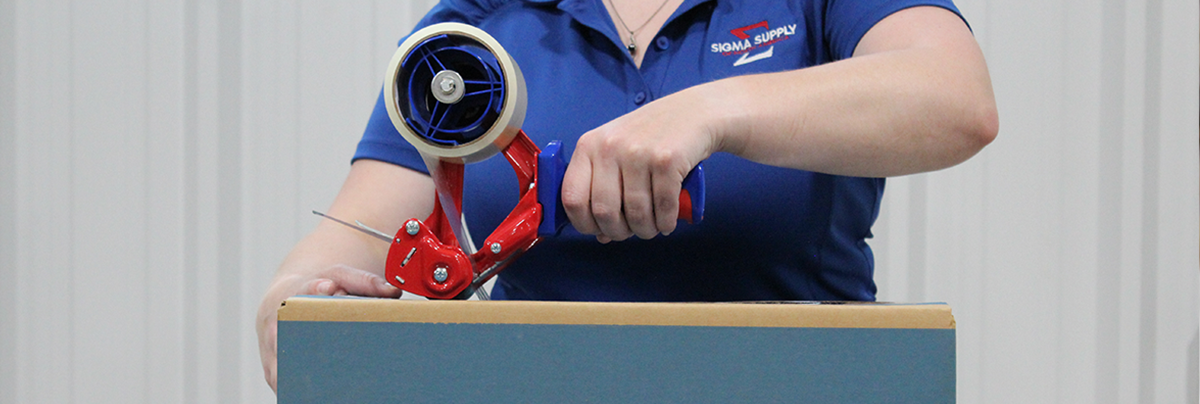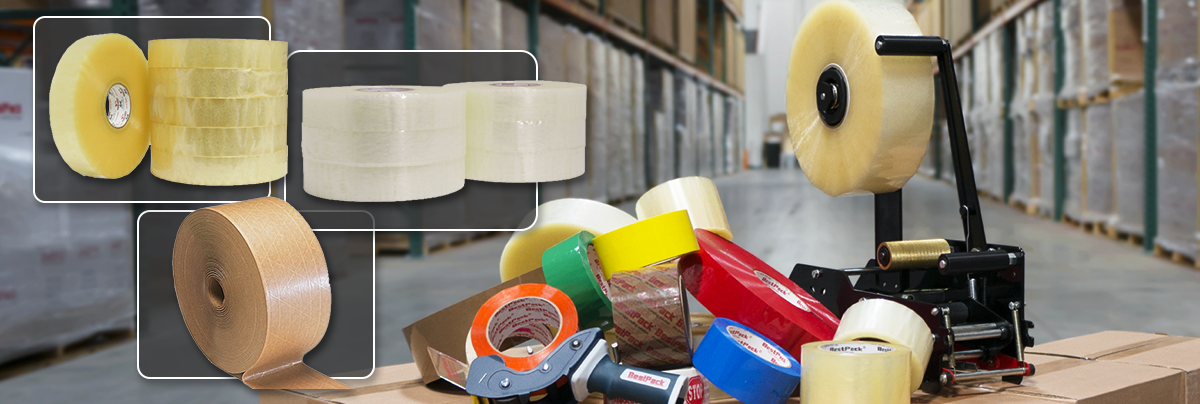No More Sticky Situations! Your Guide to Choosing the Right Packaging Tape

Are you in a sticky situation trying to decide between different types of packaging tapes?
Whether it’s for long-term or short-term storage, shipping, hand-held or industrial equipment, it can be challenging to determine what tape is best for you.
Typically, the adhesive is the most important part of the tape, and we’ll share more details about that in just a moment. First, let’s review some basic tape terminology:
Tape Terminology
- Backing/Carrier: The material that is on the outside of the tape, usually made from paper, cloth, plastic, or rubber.
- Tack: The initial stickiness of the adhesive part of the tape. It explains how quickly your tape will bond to the application material.
- Cohesion: The substance that makes up the adhesive and holds it together and creates the stickiness of your tape.
- Adhesion: The bond between your tape and the surface of the application. Tack and cohesion provide short-term reversible bonding, while cohesion and adhesion create a more permanent bond. Adhesion and tack produce a quick-stick type of bond. All three processes determine how well your tape adheres to any surface and for how long.
- Shear: The ‘holding power’ of your tape. It is measured by the time required for a certain amount of weight to cause the tape to come loose from a vertical plane. The better shear of a tape, the longer it will hold up.
“If the items you’re shipping are heavy, create an unequal weight within your package, or are of high value to you, you will want to use a stronger tape that is not easily dislodged,” said Sara Thornton, Purchasing Specialist for tape at Envoy Solutions.
Types of Tape Adhesives
Now that we’ve defined the key terms let’s take a deeper dive into tape adhesives because they can significantly impact the quality of your packaging. Here’s a breakdown of the most common types of adhesives.
- Water-Activated: Water-activated tape is starch-based, made from synthetic fibers, and typically used for corrugated packaging materials. It’s environmentally friendly and tamper-evident (useful to help tell if a package has been opened.)
- Hot Melt: Hot melt tape, made from a polymer by combining resin and wax, is versatile with superior hold. This product is effective on difficult surfaces, fast to tack, easy to apply, and adheres to most packaging materials (cardboard, a recycled bubble mailer, and much more). Although hot melt tape is strong, it doesn’t fare well in unstable or extreme climate conditions, and it will deteriorate and discolor over time, especially when exposed to UV light, so it’s not ideal for long-term storage.
- Acrylic: Acrylic tape is created by crosslinking monomers. It comes as either water or solvent-based and is extremely resistant to degradation. Acrylic has a low shear (strength) but can be used in extreme temperatures (think freezer storage or warehouses without temperature control), can withstand no-to-high humidity, is UV resistant, and has an exceptional shelf life compared to hot melt tape. Acrylic tape may not be as durable as hot melt tape on the forefront, but it has some serious benefits depending on your application needs.

Consider these attributes of each adhesive when determining the best tape for your application:
| Characteristics | Water-Activated | Hot Melt | Acrylic |
| Lasts in extreme temperatures | ✅ | ✅ | |
| Fast adhesion | ✅ | ✅ | |
| Higher shear (strength) | ✅ | ✅ | |
| Easy to apply | ✅ | ||
| Long shelf life | ✅ | ✅ | |
| UV light resistant | ✅ | ||
| Humidity resistant | ✅ | ✅ | |
| Holds to cardboard | ✅ | ✅ | ✅ |
| Holds to plastic | ✅ | ✅ |
If you’ve been experiencing some issues with your tape, you’re not alone. It can be challenging to determine the cause, but there is always a solution! Are you dealing with any of the problems below?
- Tape won't stick to the packaging upon application
- Tape stretches or breaks during application or transit
- Tape peels off after a certain amount of time
- Inconsistent dispensing from the machine or hand-held tape applicator
- Packages pop open
- Customers complain that your packaging is hard to open
- Excessive tape waste
- Sustainability concerns
If you answered "yes" to any of the above...
Let Envoy Solutions Help You!
Choosing the correct packaging tape doesn’t have to be stressful. Take the guesswork out of the equation by letting Envoy Solutions’ tape specialists do the heavy lifting. Contact us today, and we’ll get right to work with you to find solutions for the challenges you’re facing with your current tape supply.

